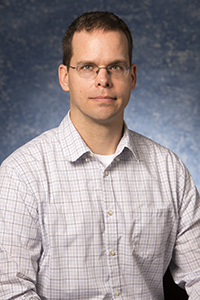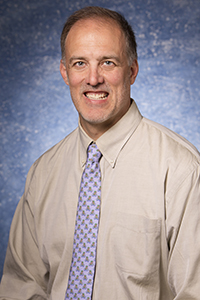Faculty Under the Microscope: A Closer Look at USciences Faculty Research

Editor's note: This article was written prior to University of the Sciences' merger with and into Saint Joseph's University and does not reflect the current, combined institution. References to programs, offices, colleges, employees, etc., may be historical information.
Faculty researchers at USciences are passionate and dedicated to their work. Three faculty members share what sparked their interest and what keeps them intrigued in their field of study.
 Jason Heindl, PhD, assistant professor of biology, received his doctorate in microbiology and molecular genetics from Harvard University. Today, Dr. Heindl shares his expertise with bacteria and microbiology with students and serves as a mentor for students interested in research in this field.
Jason Heindl, PhD, assistant professor of biology, received his doctorate in microbiology and molecular genetics from Harvard University. Today, Dr. Heindl shares his expertise with bacteria and microbiology with students and serves as a mentor for students interested in research in this field.
What made you want to get into your specific field of study?
During my time in the Peace Corps in Ghana, I had the opportunity to really consider infectious diseases and the toll they take on the individual and society. So, when I came back to the States, I decided to focus my graduate education and career on infectious diseases, specifically molecular and cellular aspects of bacterial pathogenesis.
What's your favorite part of being in the USciences community?
I enjoy collaborating with and learning from colleagues across the university. Prior to coming to USciences, I had very little opportunity to engage with practitioners of pharmacy, physical therapy, or occupational therapy, for example. Now, I interact with these folks every day and have a much deeper understanding and appreciation of their fields, among others.
What keeps you passionate about this field?
Microbes run the world. That’s the truth. Everywhere you look, there are microbes, even if you don’t see them. They clean your water, help you digest your food, clean up toxic wastes, generate oxygen, eat methane, keep soil healthy and help plants grow … I could go on and on. Although I entered microbiology intent on studying bacterial pathogenesis (which I still do), the fact is that microbes are essential to life on earth. What’s not to love?
 Isabelle Mercier, PhD, chair of the Department of Pharmaceutical Sciences, received her PhD from the University of Montreal in Montreal, Canada. In addition to being chair of the department, she serves as an associate professor of pharmaceutical sciences. Dr. Mercier’s main research interest is breast cancer.
Isabelle Mercier, PhD, chair of the Department of Pharmaceutical Sciences, received her PhD from the University of Montreal in Montreal, Canada. In addition to being chair of the department, she serves as an associate professor of pharmaceutical sciences. Dr. Mercier’s main research interest is breast cancer.
What made you want to get into your specific field of study?
My determination to specifically study and focus my research on breast cancer was catalyzed by having my favorite elementary school teacher pass away mid-way through our school year from this disease. She looked fine and healthy the week before, and the progress of the disease was just unbelievably fast and unexpected. I couldn’t understand that she was suddenly gone from my daily life. As a seven-year-old, I am not sure I decided that exact day to one day cure cancer, but I know in my heart that it did have a huge impact later on my decision to become a scientist and study breast cancer.
What is your favorite part about your field of study and what has it taught you?
Seeing students realize that their everyday experimental designs are shaping our understanding of the disease, allowing us to possibly improve or even entirely replace current therapies for more efficient ones is one of the best things as a research advisor. I have learned that cancer is almost like a fingerprint, where every tumor is different, every patient is different, and responds differently to treatments. The precision at which cancer needs to be handled and treated will become even more obvious in the years to come and hopefully will help accelerate the discoveries and treatments even more rapidly.
What is the biggest change you’ve seen in the field throughout your time?
The use of artificial intelligence in research. Everything we do in science uses computer software, massive databases and algorithms, etc.. and this is what is making the field move so rapidly. Even the next 5 years research will look entirely different and move very rapidly and we will need to adapt to this ever-changing pace, which is also very exciting
 Greg Thielman, PT, MSPT, ATC, EdD, completed his EdD in movement science at Columbia University. Dr. Thielman is a professor of physical therapy and neuroscience at USciences, and also serves as Director of the Patricia Leahy Memorial Laboratory.
Greg Thielman, PT, MSPT, ATC, EdD, completed his EdD in movement science at Columbia University. Dr. Thielman is a professor of physical therapy and neuroscience at USciences, and also serves as Director of the Patricia Leahy Memorial Laboratory.
What made you want to get into your specific field of study?
As a college football player, I had back-to-back seasons where I tore a major ligament in my knee and as I embarked on each rehabilitation program of my own I became very interested in the process and pursued a degree in physical therapy. I became interested in movement science and motor learning after working with patients early in my career. However, if you were to ask my brother this question, he would say that after our grandfather had a stroke (after a few years of me being in practice), that was the motivation that led me to this field of study.
What is the biggest change you’ve seen in the field throughout your time?
Physical therapists have traditionally been overly concerned about the need to change a patient’s motor ability and left the rest of the recovery up to other therapy specialists. Now, physical therapists’ training has evolved to be equally concerned about the extremely strong link to the cognitive and emotional changes that are necessary to rehabilitate an individual post brain insult.
What keeps you passionate about this field?
As a researcher, I have been fortunate to hold onto my early passion of being a clinical researcher, and this is because I have continuously practiced in the field throughout my career. For many years, this was doing home care physical therapy, which is quite isolating, but did afford me to practice many of the principles that I have been teaching and researching over the years. With the onset of the pandemic, I have been fortunate to return to a rehabilitation hospital environment for my practice. In my work alongside clinicians in this setting, I am very excited by the fact that many of the motor learning principles that I have been a part of supporting in my research, and abhorring to the students to integrate into their practice, are now part of standard practice for much of the therapy that I witness from clinicians.
